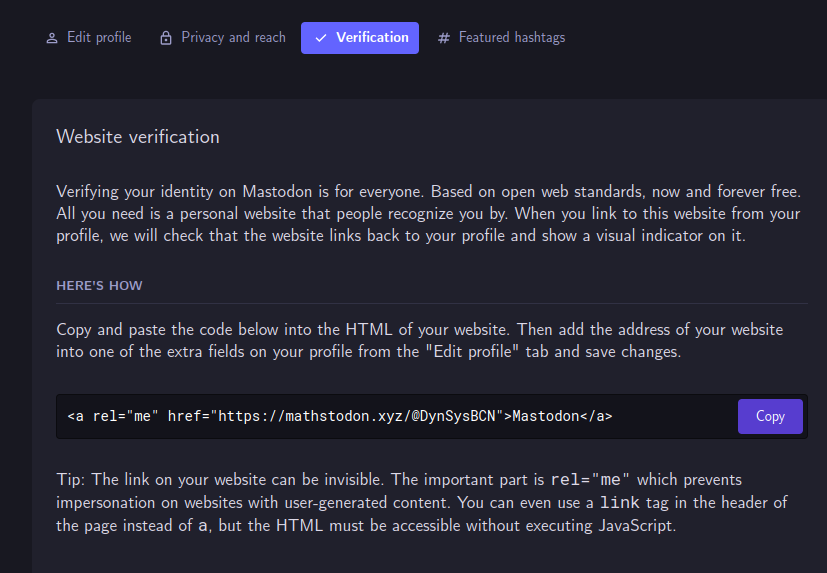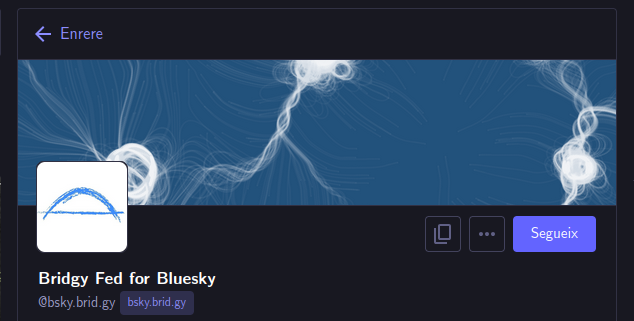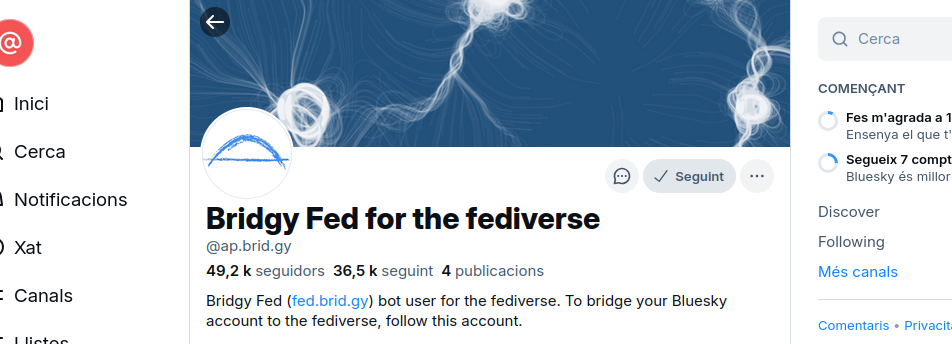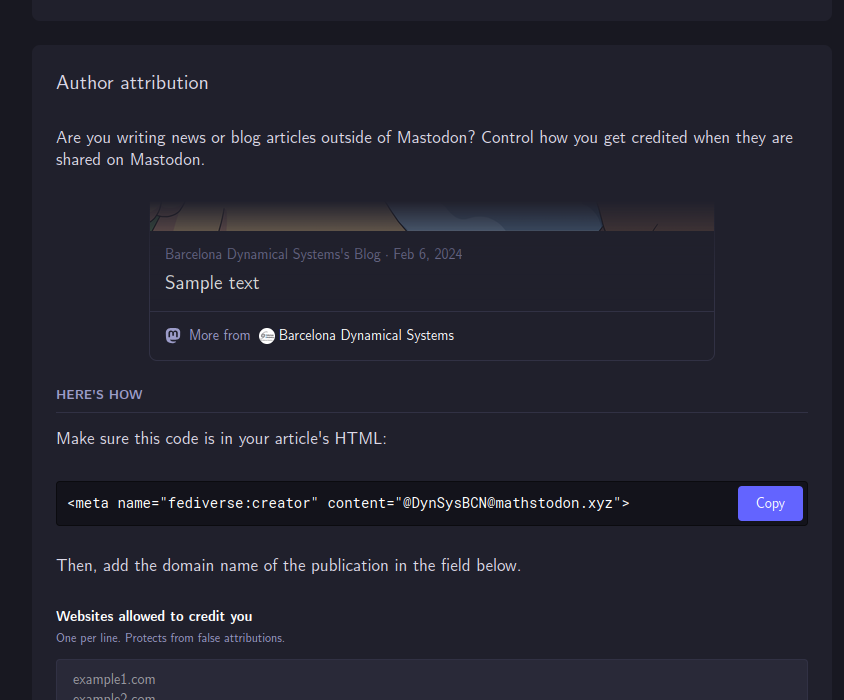flowchart LR A[Mastodon Account] <--> B[Official URL] A[Mastodon Account] <--> C[Blog] A[Mastodon Account] <--> D[Other Social Media Account]

It is now more than two years that I have been using Mastodon as a social network after quitting Twitter like so many others. In my case, it was not only that I did not want to contribute any more to corporate social media, but also that I got increasingly tired of wasting so much time scrolling without any purpose.
Mastodon does not have a recommendation algorithm, or at least I do not use it, so I am in control on what I see. Even if it can be addictive, I find it easy to manage my time there because I always reach “The End” in my timeline and I have read all posts.
There are many more advantages to this social network. Let me share some tips, more for my own record than anything else because they are well-known
Old good RSS works…
It is shocking to realize that many of the tools we can now use to avoid the biases of corporate social media were invented more than a decade ago.
RSS is one of these. It lets you follow any website for new content. Mastodon accounts even do have a RSS feed, which you can access adding .rss at the end of your URL. For instance, the RSS of my research group account
https://mathstodon.xyz/@DynSysBCN
is simply
https://mathstodon.xyz/@DynSysBCN.rss
This trick lets you generate an iframe to insert the most recent timeline into a website. For instance, inserting the following code
<p><iframe width="800" height="400" allowfullscreen="allowfullscreen" sandbox="allow-top-navigation allow-scripts allow-popups allow-popups-to-escape-sandbox" src="https://mastofeed.com/apiv2/feed?userurl=https%3A%2F%2Fmathstodon.xyz%2Fusers%2Fdynsysbcn&theme=light&size=100&header=false&replies=false&boosts=false"></iframe></p>inserts the following timeline
Verifying your account?
If you come from a social network like Twitter, you may have noticed that some accounts have the checked or verified icon associated with it. For instance in my case, imagine that I want to verify my account. What does it mean? It means that there is an actual website, which may be my home page, which reclaims a certain Mastodon account. On the Mastodon account side, there is a link to my homepage. Having verified an account means that both sites are linked and this the verification of the account. The verification process ensures that both links are checked to avoid impersonation:
To do link, go to your Mastodon profile (on the web version and not the app) and add a link to the website you want to link to in the meta field:

Then move to the verified links tab. There you will find an html code that you need to insert in your webpage. Basically it is any <a href="" rel="me" ...</a> code that points to your Mastodon account and includes the rel="me" code. This link can be hidden.

Of course, anyone could put this in their website, but verification only occurs if the links in Figure Figure 1 are two sided.
Using Quarto default options for Mastodon
Quarto already includes some options to link to your Mastodon account. In the preamble of a document or, in the case of a blog like this one, in the _quarto.yml file, you can include the following:
- icon: mastodon
href: https://mathstodon.xyz/@your_mastodon_accountand a link to your Mastodon account will appear.

There is also a quarto Mastodon extension, https://github.com/AndreasThinks/quarto-open-social-comments which looks great but I still haven’t used.
Mastodon and Bluesky Connection
Around the time I quit Twitter I decided that I didn’t want to contribute to any corporate social network and this is why I moved to Mastodon. I am very sympathetic towards people who have moved from Twitter/X to Bluesky, but I am worried that these platforms are dependent on their VCs. I was very inspired by this post at Pluralistic.
What I find great about Bluesky, and hope it will become more and more common, is the possibility to follow Mastodon accounts and to let users in Bluesky read and interact with your content.
This can be achieved through something called a bridge, which is better described in its website:
If you have a Mastodon account, see the info at https://fed.brid.gy/docs#fediverse-get-started
Go to your mastodon account and search for the user
@bsky.brid.gy@bsky.brid.gy
Click on that account and follow it.

After following this account, it will follow you back. Accept its follow to let your content be visible to Bluesky.
Bluesky users will see your account as [user].[instance].ap.brid.gy. For example, the Bluesky account @DynSysBCN.mathstodon.xyz.ap.brid.gy (see the bridged profile at Bluesky:

If you are in Bluesky and want to expose your content to Mastodon accounts, this means that it needs to be bridged, which is really easy. The idea is the same, you follow a Bluesky account which bridges your content to the other network. You can find the information in the official documentation:
On Bluesky, follow the account follow @ap.brid.gy with your Bluesky account.

and click on follow

After a few minutes, you Bluesky account will be visible at Mastodon (more generally, at the Fediverse) through
@[handle]@bsky.brid.gy. For example, I created a test Bluesky account called@animumdebesmutare.bsky.socialwhose bridged account, visible in Mastodon is@animumdebesmutare@bsky.brid.gy
If you are on Bluesky and want to follow Mastodon Accounts they need to be bridged and then you can search them directly on Bluesky:

Once you follow them, you will be visible as a follower

Your favorites (which are only visible to the admin) and your boosts are visible at the Mastodon and Bluesky accounts.
Final thoughts
Mastodon is part of the Fediverse, a set of open social networks which are interconnected through an open protocol called ActivityPub. This is a protocol approved by the World Wide Web Consortium (W3C) and safeguards its openness.
Bluesky is a private company which chose not to follow these recommendations but it lets users bridge their accounts to the fediverse. Instead of a walled garden, it is a walled garden with some gates which they are leaving open in the meanwhile. Once the user base is large enough the temptation to close the gates or to limit access may be too big. On the contrary, if the user base on the Fediverse is strong and interesting, gates will be kept open.
If you are planning to quit X, the tool https://helloquittex.com/ may help you in the transition to the fediverse.
